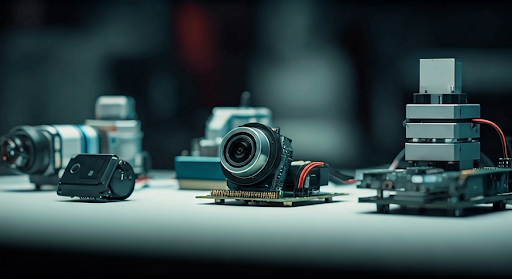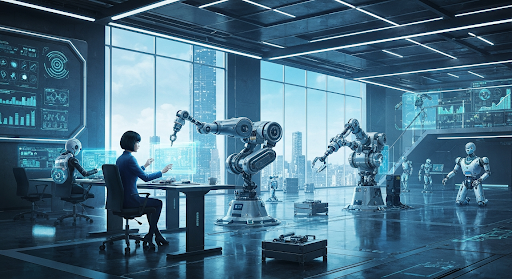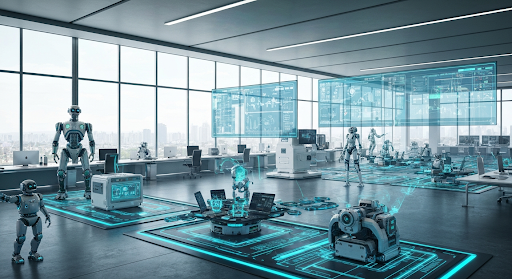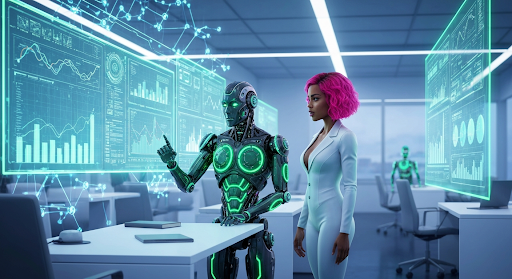Understanding Robots Automation: Key Concepts Explained
Key Highlights
- Robotic process automation (RPA) helps the business by getting software robots to take care of repetitive digital tasks. Employees can then spend their time on more strategic activities that matter the most.
- Artificial intelligence (AI) and machine learning work together to bring intelligent process automation. This lets people make better decisions and change things in real-time.
- Industrial automation uses physical robots to help run manufacturing processes. This makes the work faster and keeps everything precise.
- Business process automation is there to make workflows in the business smoother. It works to reduce human intervention in routine tasks and tries to cut down on mistakes.
- Core parts of robotics, like sensors, actuators, and controllers, work with the physical world. These pieces come together to help automate specific tasks in an effective way.
- With the use of collaborative robots (Cobots), the workplace becomes safer. Cobots help bring in human judgment and also allow for better employee satisfaction by working alongside people seamlessly.
Introduction
Robots and automation are leading the way in digital transformation. They are changing different industries and helping to do tasks with more precision and speed. By using robot automation, a business can make its work easier, get more done, and make things safer for people. There is software automation that takes care of office tasks. At the same time, there are also physical robots used in industries to help with hard and repeated work. Both these technologies are making work better for everyone. This blog will talk about the basic ideas, parts, and ways that automation helps. You will see how robot automation, software automation, and physical robots come together to solve modern problems and make our lives easier.
Defining Robots and Automation

Robots are machines made with automation technology. They are built to do jobs on their own or with little help from people. These programmable machines are really good at repetitive tasks. They can be set up to handle tough jobs too, depending on what they can do and how they are programmed.
Automation is when you use technology like software or robots to do things without people helping each time. It can make a business run better and help to avoid human error. This changes the way people look at getting work done faster and better. When you put robots and automation together, you get new ways to solve problems in both the digital world and the real world.
Core Concepts of Robotics
Robotics is about using engineering, computer science, and AI to build programmable machines for many uses. You can find these robotic systems in different shapes. Some are physical robots found in factories. Others are software solutions that help in business tasks.
A physical robot can work on its own in the real world. This is because of its strong design and computer programming. For example, robots that do welding in factories or those like vacuum cleaners at home both follow clear steps to get the job done right.
Robotics needs new technology as well. These systems often use sensors and controllers to deal with changes around them. Because of this, robots can do tasks with great accuracy in many fields. They help people in industries, move things in logistics, and even work at home with smart robotic systems and software solutions.
The Essence of Automation
Automation makes things easier by cutting down on human intervention and helping work get done faster. The main idea in process automation is to use technology for tasks. This can be with software in offices or with machines in factories.
In business processes, automation helps get rid of human error. It helps people be more productive and makes it easier to handle work. Robotic process automation uses software solutions for repetitive tasks so people on a team can look at bigger things the company needs.
With intelligent automation, AI helps companies make fast choices and change when things are different. That is why automation is important for making internal processes better and getting smarter workflows.
Key Components of Robotic Systems

Robotic systems use sensors, actuators, and controllers. These parts help robots do their jobs. Sensors take in data from the physical world, so the robot knows what is happening around it. This helps the robot make smart choices.
Actuators are like the robot's muscles. They let the robot move and pick things up. The controller is like the brain. It tells the robot what to do next.
All these parts make up the main system for robot automation. They help robots do tasks the right way and make them work well in the real world.
Sensors, Actuators, and Controllers
Robots need three main parts to work well. These are sensors, actuators, and controllers. Sensors help the robot see and hear the physical world. They collect important data so the robot can know what is around it.
Actuators and controllers help to get tasks done in the right way. For example:
| Component | Function |
|---|---|
| Sensors | Find temperature, see motion, or sense changes in the place |
| Actuators | Make things move, like a robot arm that lifts things |
| Controllers | Use information and tell the robot what to do next |
All these parts work well together. This teamwork lets the robot finish jobs on its own and do each step right.
Software and Programming in Robotics
Modern robots work using computer software. This software helps them process data, follow commands, and get used to new tasks. Many software solutions use programming with machine learning and image recognition.
Engineers use coding languages to tell robots what to do in places like factories or for moving goods. With machine learning, robots can see patterns, which helps them get better at what they do.
Robotic software lets robots adjust right away, so they stay useful when things change. These new tools keep getting better, shaping how we use intelligent automation and robotics now and in the future.
Automation Technologies Explained
Automation uses solutions like intelligent automation and rpa software to change the way people work. Intelligent automation adds AI to help with better decisions and more efficiency.
At the same time, automation technology helps keep tasks moving easily in many industries. You can see this from factory machines to the front offices. These new tools help companies do their work faster and better. They also let people keep up and stay ahead of others in the field.
Types of Automation: Fixed, Programmable, and Flexible
There are different types of automation that are used for different needs in the industry. These are known as fixed, programmable, and flexible automation.
- Fixed automation is best for repetitive tasks, like on assembly lines when making cars or trucks.
- Programmable automation lets people change production by setting up robotic systems in other ways.
- Flexible automation makes it easy to swap out processes or products. This works well for industries that change a lot.
Every type helps make manufacturing better. They help things fit together well in many areas of work.
Industrial vs. Office Automation
While industrial automation uses physical robots to boost how things are made, office automation makes office work better by using software systems.
In factories, robotic arms take care of welding or packing jobs. This cuts down on the need for people to do these tasks by hand and makes things run faster. Office automation uses RPA bots to handle repetitive digital tasks. These can be things like processing data or setting up appointments.
Both industrial automation and office automation give what different industries need to work their best. They help both hands-on factories and office settings do more.
How Robots and Automation Work Together
The integration of AI with robots helps to bring together process automation and robot automation. When you combine robot automation with intelligent process automation, industries can work better. They can do more work with less help from people.
This teamwork happens in many places, like factory floors and office spaces. Automation is used to take care of repetitive tasks, predict what might happen next, and find new ways to work that are not like the old ones.
Collaborative Robots (Cobots) in the Workplace
The use of collaborative robots, also called cobots, in the workplace is changing industrial automation in a big way. Unlike old industrial robots that work alone, cobots are made to be with people. They help boost how much work gets done and cut down the need for human intervention. Cobots are very good at dealing with repetitive tasks. This lets employees spend more time on strategic activities. Now, thanks to artificial intelligence and machine learning, these robots can learn from their surroundings and adjust to new things. This lowers human error and makes everything run better and smoother.
Integrating Automation into Existing Processes
Automation smoothly fits into the way things are done now. It helps make internal processes better and fixes problems in the way work gets done. The main steps include:
- Using process mining tools to find places where automation can help.
- Making business tasks better, like when you do data entry or work with inventory management.
- Growing automation to meet different needs as the group changes.
All of this helps people work better. It also keeps up with new changes in technology.
Benefits and Challenges of Robots Automation
The benefits of RPA are big. It can help increase how well people work, save money, and speed up business process automation. With automation, you need less manual effort. This means there are fewer mistakes in the work you do.
But, there are still some things to watch out for. RPA can struggle with complex tasks, and getting it to work well with your business process can be hard. To make the most of process automation, people must work on these issues.
Productivity Gains and Cost Savings
Automation helps people get more work done by keeping things running the same way every time. For example, when there is an automated production line, robots can work all day and night without stopping.
There are also cost savings. This is because there are fewer mistakes and jobs get done in a better way. Companies can use their people and money for other things, like trying new ideas and doing strategic activities. This makes the whole business do better.
Potential Risks and Limitations
Even though there are some good things about automation, there are also some problems. If you use one form of RPA too much, it might not work well with complex tasks. When this happens, you still need human help to get things done right.
Another thing to watch out for is when mistakes happen because of bad programming. Good management is needed to make sure that automation works with people and does not take over everything. Automation should help people, not fully replace them.
Conclusion
To sum up, knowing about robots and automation is important in today’s fast-changing world of technology. When you learn the main ideas and how robotic systems work, people and businesses can get the most out of these tools. Using robots in different jobs can help you get more done and save money. But there are also some new problems and things to think about. As we go ahead, it is good to keep up with new trends and what automation may mean for us. This will help you be ready and do well as things change. If you want to see how automation can help make your work easier and get more done, reach out for a consultation today!
Frequently Asked Questions
What industries benefit most from robots automation?
Industries like manufacturing, financial services, and customer service use industrial robots and process automation to make work faster and better. Business process automation is also used by those in logistics and healthcare. These steps help their business process run smoothly with little need for people to step in.
Are robots replacing human jobs?
Robots do not take over all human work, but instead help people by working with them. As said in Harvard Business Review, when robots do repetitive tasks, people have more time to focus on important work. This helps keep a good mix of human intervention and machine use.
Can automation exist without physical robots?
Yes, automation many times relies on things called software robots or rpa bots. They work on virtual tasks for people or companies. With software automation, there is no need to have physical robots. This helps make work simpler and faster. It also uses smart ways, like intelligent automation, to make things better.
What skills are needed to work with automation technologies?
You need to know about computer science, machine learning, and image recognition to work with software solutions. People who keep up with digital transformation trends can help put automation systems in place and keep them running well.
What are the emerging trends in robots automation?
Trends such as the increased integration of AI, smarter automation, and intelligent process automation are changing the way we work. Developments in computer vision and business process automation help robots adjust in real-time to what they need to do. This can make the business process better and boost efficiency for all of us.



